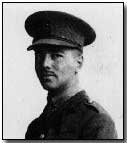Encyclopedia - Shell Shock
 Shell Shock was a term used
during the First World War to describe the psychological trauma suffered by
men serving on the war's key battlefronts - France, Flanders, along the
Isonzo and in Gallipoli.
Shell Shock was a term used
during the First World War to describe the psychological trauma suffered by
men serving on the war's key battlefronts - France, Flanders, along the
Isonzo and in Gallipoli.
The intensity of the essentially artillery battles fought along these war fronts - most notably in France and Flanders; hence the tag popularly applied to the disorder - often caused neurotic cracks to appear in otherwise mentally stable soldiers.
Men who saw service of any great length on an active front quickly came to recognise the symptoms of shell shock among their fellow men. Recognition in the form of military authority was rather slower to develop. At first shell shock victims were believed to be suffering from the direct physical effects of shell blasts, or from a form of monoxide poisoning.
Symptoms varied widely in intensity, ranging from moderate panic attacks - which sometimes caused men to flee the battlefield: a crime which was invariably regarded as rank cowardice and which resulted in a court martial for desertion - to effective mental and physical paralysis.
Sent home to recover many shell shock victims recovered over time, whereas many others continued to feel its effects for years afterwards.
Treatment for shell shock was primitive at best and dangerous at worst; psychological theories governing its treatment developed only gradually. Reliable figures relating to the total number of shell shock sufferers are not available.
Click here to read W H Rivers' 1917 paper, The Repression of War Experience, in which he details the treatment of shell shock, including illustrative cases.
A Kite Balloon was an observation balloon controlled by a cable from the ground.
- Did you know?
